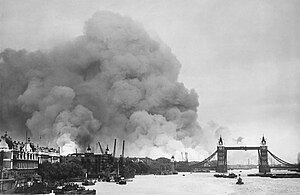1949 bombing of Titania
| 1949 bombing of Titania | |||||||
|---|---|---|---|---|---|---|---|
| Part of the strategic bombing campaign of the World War | |||||||
 Smoke rises over Titania on October 19th, 1949 | |||||||
| |||||||
| Belligerents | |||||||
|
|
| ||||||
| Commanders and leaders | |||||||
| Casualties and losses | |||||||
|
–17,800 civilians killed ~36,000–39,000 injured 400,000 houses damaged or destroyed (60 percent of these in Titania) |
Unknown 663 aircrew 865 aircraft | ||||||
The 1949 bombing of Titania, also known in Zamastan and specifically Titania as the Nights of Fire, was a 52-day period of consistent aerial bombing campaigns against the Zamastanian port city of Titania by Drambenburg during the World War. The Drambenburgians conducted mass air attacks against industrial targets, towns, and cities, beginning with raids on Titania's central neighborhoods. Most notable was a large daylight attack against the city on 19 October which killed over 9,800 civilians. The Lutwaffe gradually decreased daylight operations in favor of night attacks to evade attacks by the ZDAF.
The bombing was largely done in an attempt to cripple the ports and dry docks utilized by the Zamastanian Naval Forces, which was a strategically close geographic location near Drambenburg from where the Zamastanians were refueling many of their large scale naval operations. Kaiser Geoff III von Wettin hoped that the bombing would break Zamastanian morale to the point where forces on the front lines would cave to a Drambenburgian land incursion to seize Titania, but eventually the Luftwaffe had to scale back their bombing to preserve aircraft as gains were made by the Allies on other fronts of the war.
Over 17,800 civilians died during the course of the bombing campaign, along with more than 36,000 who were injured. The bombings had the effect of galvanizing the Zamastanian public to the war effort, which had previously been severely lacking. President Marvin Gaviria often cited the events as evidence to the reason for joining the war in the first place, stating that if Zamastan hadn't joined the war then more cities would suffer the fate that Titania did. The bombings shaped the culture and identity of Titania after the war, as more than 60% of the city needed repair or reconstruction from the damage done.